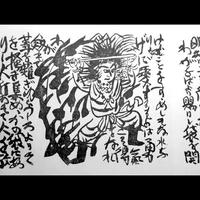棟方 志 功(39)
むなかた|し|こう
Munehō||
Munakata|will|work
Shiko Munakata (39).
Shiko Munakata (39)
Shiko Munakata (39).
무타카타 시코오(39)
Shiko Munakata (39).
Shiko Munakata (39).
Shiko Munakata (39).
Сико Мунаката (39).
宗像志子(39 岁)。
宗像志子(39 岁)。
こんにちは 。 人 から 分かる 3 分 美術史 。 今日 は 棟方 志 功 に ついて 勉強 して いき ましょう 。
|じん||わかる|ぶん|びじゅつ し|きょう||むなかた|こころざし|し|こう||べんきょう|||
||||||||Munakata||||||||
||from|||art history|||Munakata|志|achievement||||||
Hello . Three minutes of art history from a human being. Today, let's learn about Shiko Munakata.
棟方 志 功 。1903 年 生まれ 。20 世紀 の 日本 を 代表 する 版画家 と して 知ら れ ます 。
むなかた|し|こう|とし|うまれ|せいき||にっぽん||だいひょう||はんが か|||しら||
|||||||||repräsentiert||Druckgrafiker|||||
Munakata|||||century||||||printmaker|||||
Shiko Munakata. Born in 1903. Known as one of the leading printmakers of Japan in the 20th century.
志 功 は 、 青森 県 の 刀鍛冶 の 息子 と して 生まれ ました 。
し|こう||あおもり|けん||かたな かじ||むすこ|||うまれ|
||||||Schmied||||||
|||Aomori|prefecture||swordsmith||son||||
Shiko was born in Aomori Prefecture, the son of a sword smith.
小学校 を 卒業 後 鍛冶屋 を 手伝い ながら 趣味 で 武者絵 を 描いて 過ごし ます 。
しょうがっこう||そつぎょう|あと|かじや||てつだい||しゅみ||むしゃ え||えがいて|すごし|
||||||||||Samurai-Bilder||||
||||||||||warrior painting||drawing||
After graduating from elementary school, he spent his time helping out at a blacksmith shop and painting samurai pictures as a hobby.
18 歳 の 頃 に 青森 在住 の 洋画家 ・ 小野 忠明 から ゴッホ の 「 ひまわり 」 を 教え られ 衝撃 を 受け ました 。
さい||ころ||あおもり|ざいじゅう||ようが か|おの|ただあき||||||おしえ||しょうげき||うけ|
|||||||Maler|Ono|Tadaaki||Van Gogh||Sonnenblumen|||||||
|||||living||Western painter|Ono|Tadaaki||||||taught|taught|shock|||
At the age of 18, I was shocked when I was taught about Van Gogh's 'Sunflowers' by the Western painter Tadaaki Ono, who lived in Aomori.
そこ で 志 功 は 「 ゴッホ に なる 」 と 豪語 し 画家 を 志す ように なり ます 。
||し|こう||||||ごうご||がか||こころざす|||
|||||||||großspurig||||streben|||
||will|achievement||Van Gogh||||boast||painter||aspire to|||
At that point, Shiko declared that he would 'become Van Gogh' and began to aspire to be a painter.
1924 年 、21 歳 の 志功 は 東京 に 移住 。 内職 で 生計 を 立て ながら 帝展 に 出品 を し ます が 、 落選 を 続け ます 。
とし|さい||こころざし こう|ゆきのり|とうきょう||いじゅう|ないしょく||せいけい||たて||ていてん||しゅっぴん|||||らくせん||つづけ|
|||Shiko|||||Heimarbeit||||||||||||||||
|||Shiko||||moved to|side job||livelihood||||Imperial Exhibition||submission|||||rejection||continues to fail|
In 1924, at the age of 21, Shiko moved to Tokyo. He supported himself through side jobs while submitting works to the Imperial Exhibition, but continued to be rejected.
1928 年 に は 版 画家 ・ 川上 澄 生 の 「 初夏 の 風 」 に 影響 を 受け 、 版画 に 転向 。
とし|||はん|がか|かわかみ|きよし|すみ||しょか||かぜ||えいきょう||うけ|はんが||てんこう
|||||Kawakami|||||||||||Druckgrafik||
|||print||Kawakami Sumio|Sumi|Sumio||early summer||||influence|||woodblock print||shifted to
In 1928, influenced by the printmaker Sumio Kawakami's 'Early Summer Wind', he shifted to printmaking.
その頃 の 志 功 の 作品 が 「 星座 の 花嫁 」 です 。 川上 に 倣い 、 文明開化 の 貴婦人 を モデル と して い ます 。
そのころ||し|こう||さくひん||せいざ||はなよめ||かわかみ||ならい|ぶんめい かいか||きふじん||もでる||||
|||||||||||||nachahmen|Zivilisation und Aufklärung||||||||
|||||||constellation||bride||||following|civilization and enlightenment|of|lady||||||
At that time, Shi Kou's work is 'Bride of the Constellations'. Following Kawakami, it models a noblewoman of the era of civilization and enlightenment.
その後 、 生活 が 苦しい ながら も 、 志 功 は 版 画家 と して いく つ か の 賞 を 取り 始め ました 。
そのご|せいかつ||くるしい|||し|こう||はん|がか|||||||しょう||とり|はじめ|
|||||||||printing|printmaker|||to continue||||prizes||||
Afterward, although life was difficult, Shi Kou began to win several awards as a printmaker.
そんな 中 、33 歳 の 志 功 が 発表 した 作品 が 「 大和 し 美し 」 です 。
|なか|さい||し|こう||はっぴょう||さくひん||やまと||うつくし|
|||||||announcement||work||Yamato||beautiful|
Amidst this, at the age of 33, Shi Kou announced the work 'Beautiful Yamato'.
「 大和 し 美し 」 は 志 功 の 出世 作 と なり 、 これ が きっかけ で 民芸 派 の 柳 宗 悦 、 河井 寛 次郎 ら と 知り合い ます 。
やまと||うつくし||し|こう||しゅっせ|さく|||||||みんげい|は||やなぎ|そう|えつ|かわい|ひろし|じろう|||しりあい|
|||||||||||||||||||||Kawai||||||
||beautiful|||||success||||||opportunity||folk art|||Yanagi|Soo|悦|Kawai|Kan|||||
Yamato Shibi became a famous work of the artist Shiko, and this was the opportunity for him to meet folk art figures such as Yanagi Sōetsu and Kawachi Kanjiro.
そして 河井 を 師 と 仰いだ 志 功 は 、 民芸 派 の 一員 と して 活動 を する ように なり ます 。
|かわい||し||あおいだ|し|こう||みんげい|は||いちいん|||かつどう|||||
|Kawai||||||||Mingei|||||||||||
|Kawai||master||regarded||||folk crafts|school||a member|||activity|||||
Thus, Shiko, who regarded Kawachi as a mentor, began to engage in activities as a member of the folk art movement.
志 功 は 間も無く 最初の 宗教 的 作品 「 華厳 譜 」 を 制作 し ます 。
し|こう||まもなく|さいしょの|しゅうきょう|てき|さくひん|はなげん|ふ||せいさく||
||||||||Kegon|||||
|||soon||religion|||Kegon|score||will create||
Before long, Shiko produced his first religious work, 'Kegonfu.'
その後 も 仏教 を モチーフ と した 制作 を 続け 、37 歳 の 志 功 が 制作 した 作品 が 「 釈迦 十 大 弟子 」 です 。
そのご||ぶっきょう||もちーふ|||せいさく||つづけ|さい||し|こう||せいさく||さくひん||しゃか|じゅう|だい|でし|
||Buddhism||theme|||production||continued||||||creation||work||Buddha|ten|great|disciple|
After that, he continued to create works inspired by Buddhism, and the piece created by Shiko at the age of 37 is 'The Ten Great Disciples of Shakyamuni.'
この頃 の 志 功 の 木版画 は ドイツ 表現 主義 の 影響 を 受けて おり 、 土 俗 的 ながら モダンな 外観 と なって い ます 。
このごろ||し|こう||もくはん が||どいつ|ひょうげん|しゅぎ||えいきょう||うけて||つち|ぞく|てき||もだんな|がいかん||||
|||||Holzschnitt|||||||||||||||||||
|||||woodblock print|||expression|expressionism||||||earth|rustic||||modern appearance||||
At this time, Shiko's woodblock prints were influenced by German Expressionism, resulting in a modern yet rustic appearance.
戦後 に なる と 、 小説 など の 挿絵 を 多く 手がけ ました 。
せんご||||しょうせつ|||さしえ||おおく|てがけ|
after the war||||novel|||illustration|||worked on|
After the war, he worked on many illustrations for novels and other works.
中でも 谷崎 潤 一郎 の 鍵 の 挿絵 の 一 つ と して 、 浮世絵 の 大 首 絵 から 着想 した 「 大 首 の 柵 」 を 制作 。
なかでも|たにざき|じゅん|いちろう||かぎ||さしえ||ひと||||うきよ え||おお|くび|え||ちゃくそう||だい|くび||さく||せいさく
|Tanizaki||||||||||||||||||Inspiration|||||||
|Tanizaki|Jun|||key||illustration|||||| Ukiyo-e|||||||||||||
Among them, as one of the illustrations for Junichiro Tanizaki's key, he produced "Fence of the Great Head," inspired by the ukiyoe painting "Oshukue no fen" (The Great Head).
これ が のち に 、 志 功 の 美人 大 首 絵 の シリーズ に つながって いき ます 。
||||し|こう||びじん|だい|くび|え||しりーず||||
||||||||||||series||will connect||
This later led to Shiko's series of paintings of beautiful women.
晩年 と なる 65 歳 の 時 の 作品 である 「 弁財天 妃 の 柵 」 は 美人 大首絵 の 傑作 と して 知ら れ 、
ばんねん|||さい||じ||さくひん||べんざいてん|きさき||さく||びじん|だい くび え||けっさく|||しら|
späten Jahren|||||||||Benzaiten|die Königin|||||Großes Kopfporträt||||||
later years|||||time||||Benzaiten|princess||fence|||big head picture||masterpiece||||
Fence of Princess Benzaiten, painted in his later years at the age of 65, is known as a masterpiece of painting with a beautiful woman at the head,
肉感的 な 女性 の 描写 、 和紙 の 裏表 から 施した 彩 色 など 、 志 功 芸術 の 集大成 と も 言え ます 。
にく かん てき||じょせい||びょうしゃ|わし||うらおもて||ほどこした|さい|しき||し|こう|げいじゅつ||しゅうたいせい|||いえ|
fleischlich|||||washi||||||||||||Gesamtschöpfung||||
fleshy||||depiction|washi||both sides|from|applied|color|color||||art||culmination||||
Shikō's art is a culmination of his sensual depictions of women and his use of colors from the reverse side of Japanese paper.
こうして 国内外 の 多く の 賞 を 受賞 し 、 名実共に 日本 を 代表 する 作家 と なった 志 功 は 、1975 年 に 72 歳 で 亡くなり ました 。
|くに ないがい||おおく||しょう||じゅしょう||めいじつともに|にっぽん||だいひょう||さっか|||し|こう||とし||さい||なくなり|
|In- und Ausland||||||||namentlich und tatsächlich||||||||||||||||
|domestic and foreign||||award||won awards||both name and reality|||||writer|||||||||||
Shiko, who won many national and international awards and became one of Japan's most celebrated writers, died in 1975 at the age of 72.
以上
いじょう

